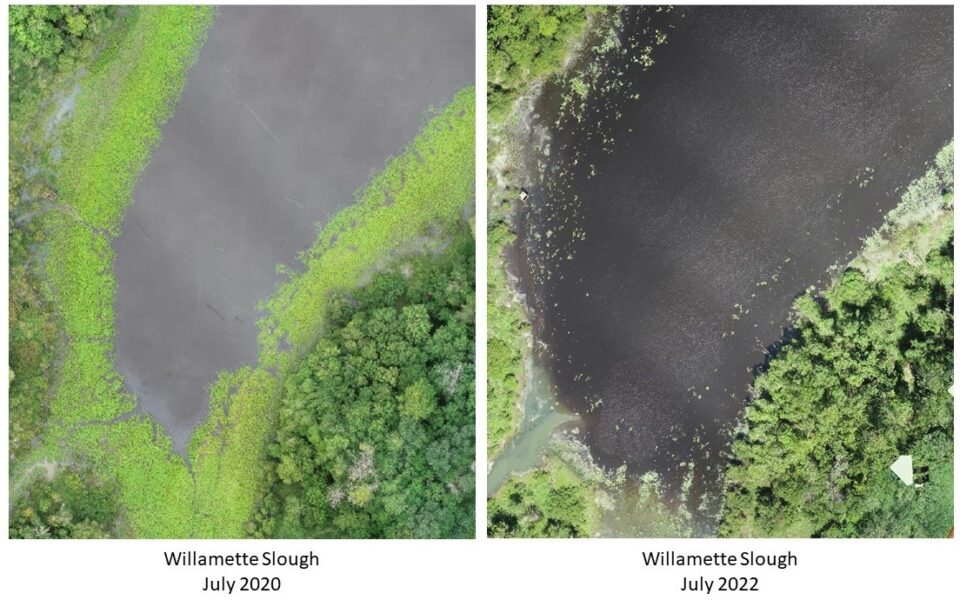Salem, Ore. — The City of Salem and Willamette Riverkeeper are gearing up for the fourth and final year of targeted treatment of an invasive water plant in the Willamette Slough. Uruguayan water primrose, also called Ludwigia, had gained a stranglehold on the Willamette Slough at Minto Brown Island Park in prior years, hurting recreation opportunities and wildlife alike.
This year’s first round of treatment begins Monday, July 24, and is expected to run through Friday, July 28. A follow-up treatment is scheduled during the week of September 5, following Labor Day weekend. Willamette Riverkeeper and City of Salem staff will provide outreach to those who use the river during this time.
Signage about the project and restricted uses will be posted at Minto-Brown, Wallace Marine, and Riverfront Parks. Local watercraft rental businesses, the Willamette Queen, and project partners are being notified. Web, media and social media updates are also scheduled.
Ludwigia forms dense mats in slow-moving backwater channels, oxbow lakes, and sloughs. While this yellow-flowered plant may appear quite pretty, it has the potential to choke entire waterways, severely restricting recreational access, degrading water quality, and creating an environment that is unfriendly to native fish and wildlife.
Up and down the Willamette River, groups have been working to stop the spread of this highly invasive plant. Since 2020, the City of Salem and Willamette Riverkeeper have been teaming up to do the same in the Willamette Slough. This four-year project aims to control Ludwigia in the slough through the careful use of an aquatic-approved herbicide sprayed on the plants by state-licensed applicators. Treatments will continue through the summer of 2023.
The goal is to reduce the plant’s population to such a degree that additional herbicide treatment will not be necessary once the project is complete. In March 2023, over 12,500 native trees and shrubs were planted in the slough’s riparian areas where Ludwigia had been effectively removed. Once established, these native plants will provide shading to the shoreline and reduce habitat for sun-loving invasive species like Ludwigia. In the future, any new or remaining Ludwigia will be controlled by hand-pulling.
Three years of herbicide treatment have occurred, with one spray event in July and a follow-up in August or September of each year. The effect of those treatments is already quite noticeable; the extent of Ludwigia in the slough is now substantially reduced from what it was before the first treatment.
Recreational users are advised to steer clear of the slough while treatment is in progress and for 24 hours after the last scheduled treatment day to limit potential exposure to the herbicides and to ensure maximum treatment effect. Treated plants will show signs of a blue-green dye, which is mixed with the herbicide so that applicators can see where it has been applied and reduce the amount of herbicide needed for control efforts.
Funding for this project was provided to Willamette Riverkeeper by Meyer Memorial Trust and Bonneville Power Administration.
More about Ludwigia
The Willamette Slough was identified by the Willamette Aquatic Invasive Network as having a large source population of Ludwigia. Ludwigia spreads long distances through plant fragments and by seeds. During high water events the plant is most likely to move downstream with the flow of the river and establish new populations at other riverside and off-channel habitats. Due to its location, treating Ludwigia in the Willamette Slough will help reduce its downstream spread.
Invasive aquatic plants and animals can also be dispersed by watercraft so it is important to clean, drain, and dry your boat before transferring it to another waterbody.
Additional information about restoration efforts in the Minto Brown Island Park Conservation Area can be found online at Restoring the Willamette River.









